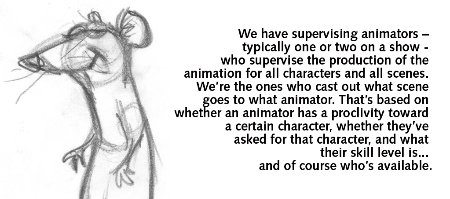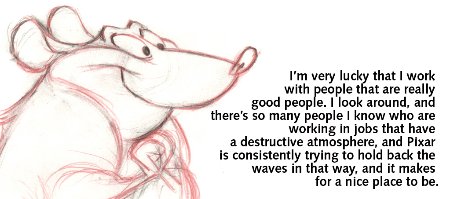Rhett Wickham: Every Little Thing That Goes Into the Soup
Page 3 of 4

Click here for a much larger version of this picture
RW
What did you learn from this film or from these characters?
MW
Oh, so many things. I was on Ratatouille for four years. I think I said earlier that I worked on every film since Bugs Life, except that I wasn’t able to work on Cars because I was too busy with Ratatouille. And after four years and several directors, a huge crew, trying to get so much done at the last minute, I mean …(he pauses for a moment).
There’s a lot to learn about having a great idea. It’s one thing to have a dream, and it’s another thing to be able to see it through. When you have so many people, it’s really important to get everybody on board with your dream about it, with your goal and what you want to do with the film and why it’s important. I really learned a lot from Brad Bird and watching that.
Because, you know, everyone has such a small part on these movies and some of them will have to stay late, or all night maybe to work on their tiny little piece, and it’s so helpful if everyone understands why their tiny little piece is important to the overall goal, and why the overall goal is important.
I also learned a lot about people and how it’s one thing to work on a film for a long time, and it’s one thing to have a huge influence, but it’s so important to have people that you enjoy working with. I’m very lucky that I work with people that are really good people. I look around, and there’s so many people I know who are working in jobs that have a destructive atmosphere, and Pixar is consistently trying to hold back the waves in that way, and it makes for a nice place to be.
What I learned above everything else, because it was made in a very short amount of time and it’s our most complex film, in the shortest amount of time with the largest crew – what I learned is that everybody’s tired, and you really have to be sensitive to where everyone is personally. You want it to be just about the work, always about the work, but sometimes you go into somebody’s office and it’s just about the work but they need to go home. It’s so nice to have leadership that recognizes that human element, and can look after people. People aren’t machines, they’re human beings. And that’s what’s wonderful about Pixar is that they bring a sensitivity to it, and an emotional understanding. I learned how important it is to not only cater to the artistic concerns of the individual, but also to the person, especially when times are tough. You have to let people know it’s a safe place to make mistakes, to try something different.
RW
I want to go back to something you said earlier. You talked about having to remember that it is a flat graphic, moving. And it strikes me that as Pixar has progressed, it has become more and more aware of that principal and how it applies to animating in CG. In a way, the craft seems to be following a path that’s more akin to a mobius strip; that is that the further the medium has moved away from 2D the closer it’s come back to the place from which animation started. This film seems to be embracing the same principals and attempting to capture them rather than attempting to mimic life so strictly.
In many ways it puts to rest a lot of the arguments against CG. The graphic styling, the extremes, the way characters are pushed, and things like hard lines rather than subtle shadows.
MW
It’s funny that you mentioned 101 Dalmatians earlier, because we looked to Dalmatians for our animation. But as far as the look goes, and I say this without having spoken to our Director of Photography, but it looks like Pinocchio to me.
RW
It does, at times it truly does.
MW
It really feels like a warm, inviting world to come into.

Click here for a much larger version of this picture
